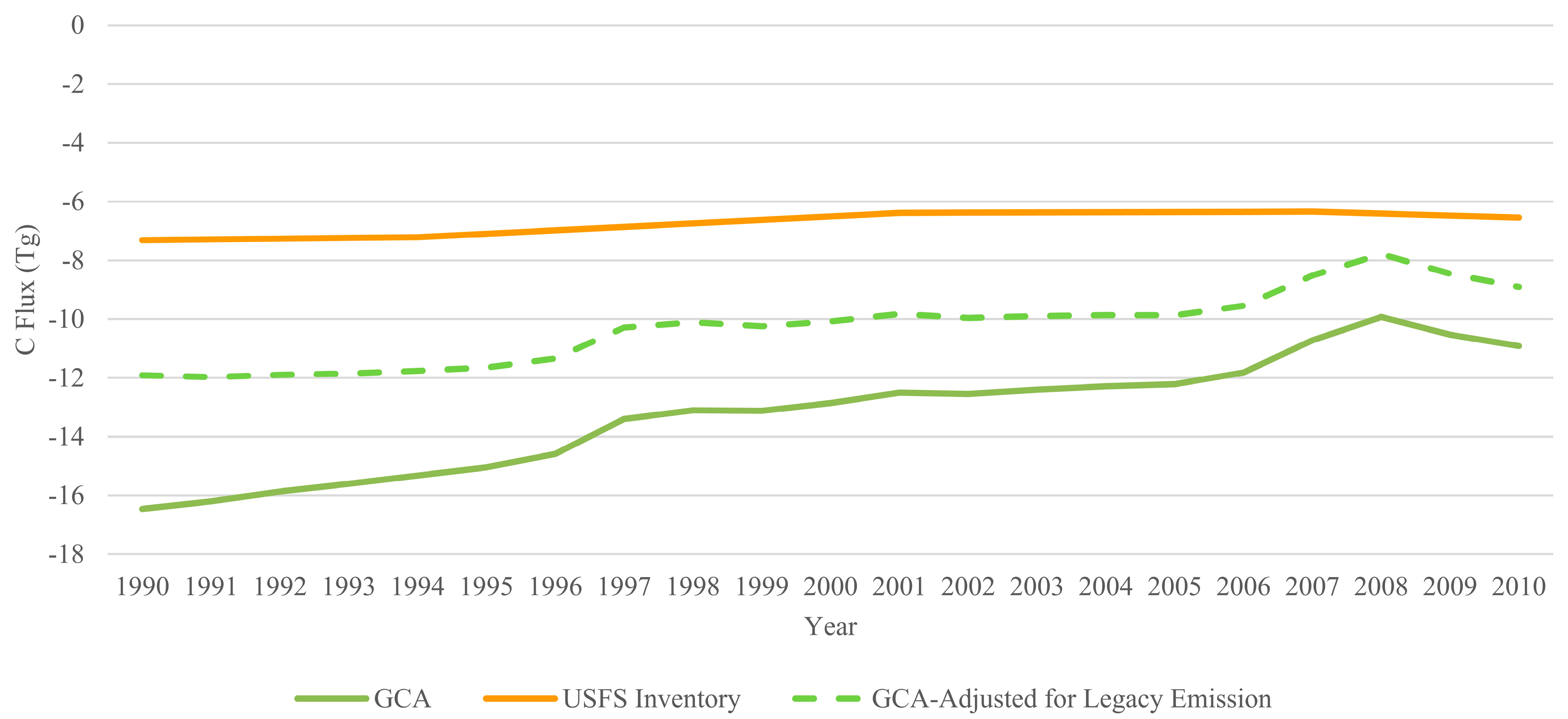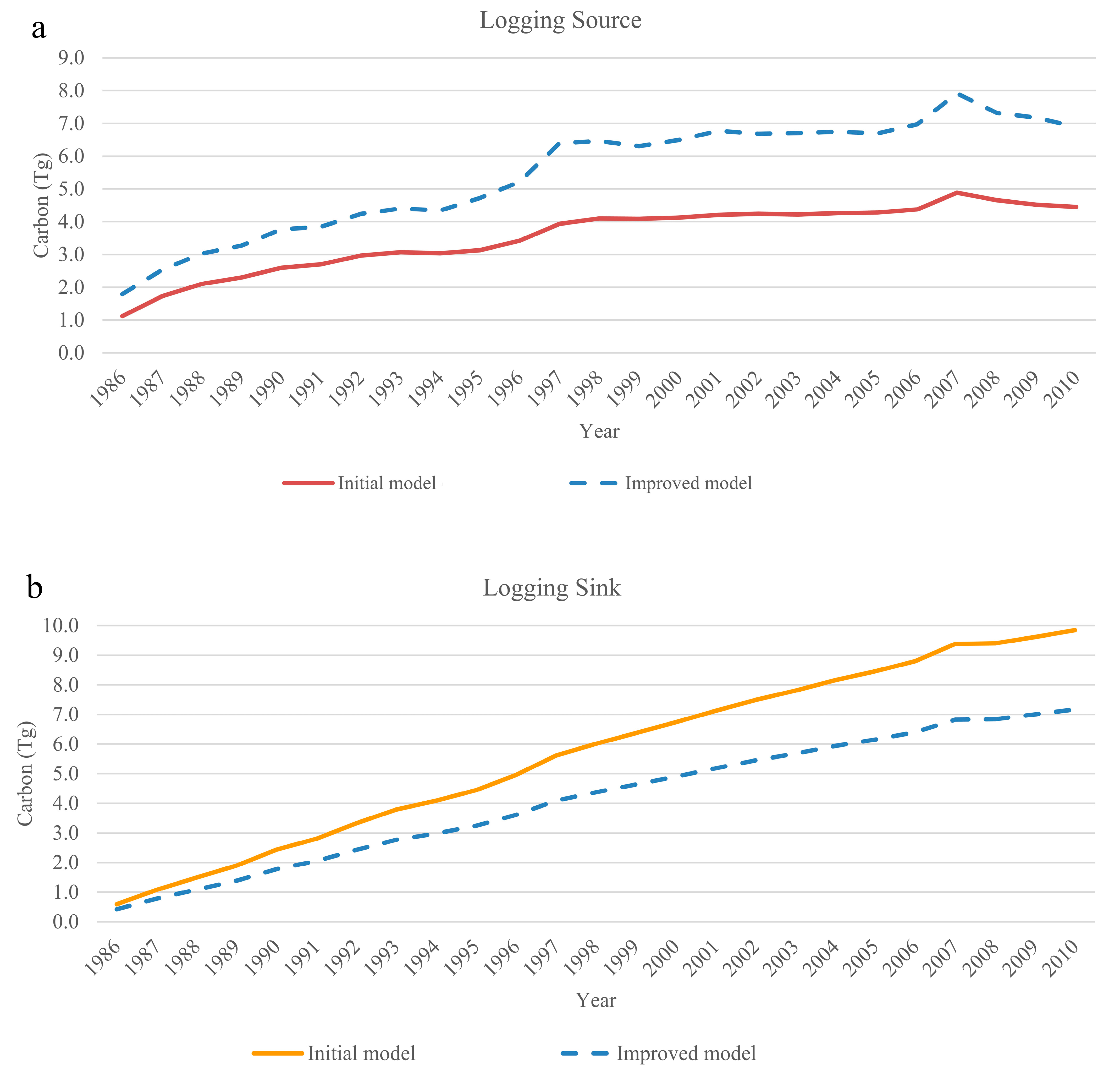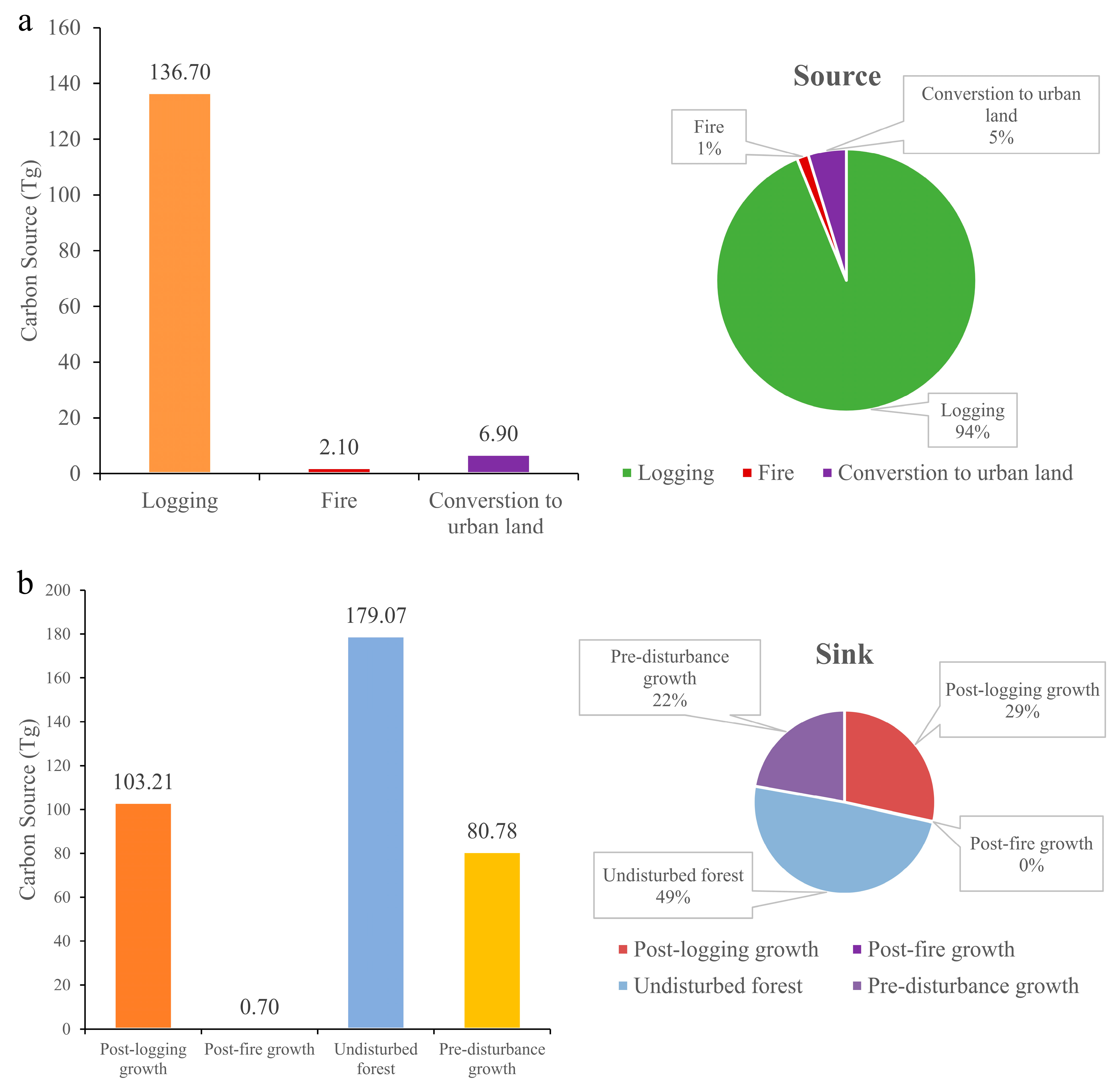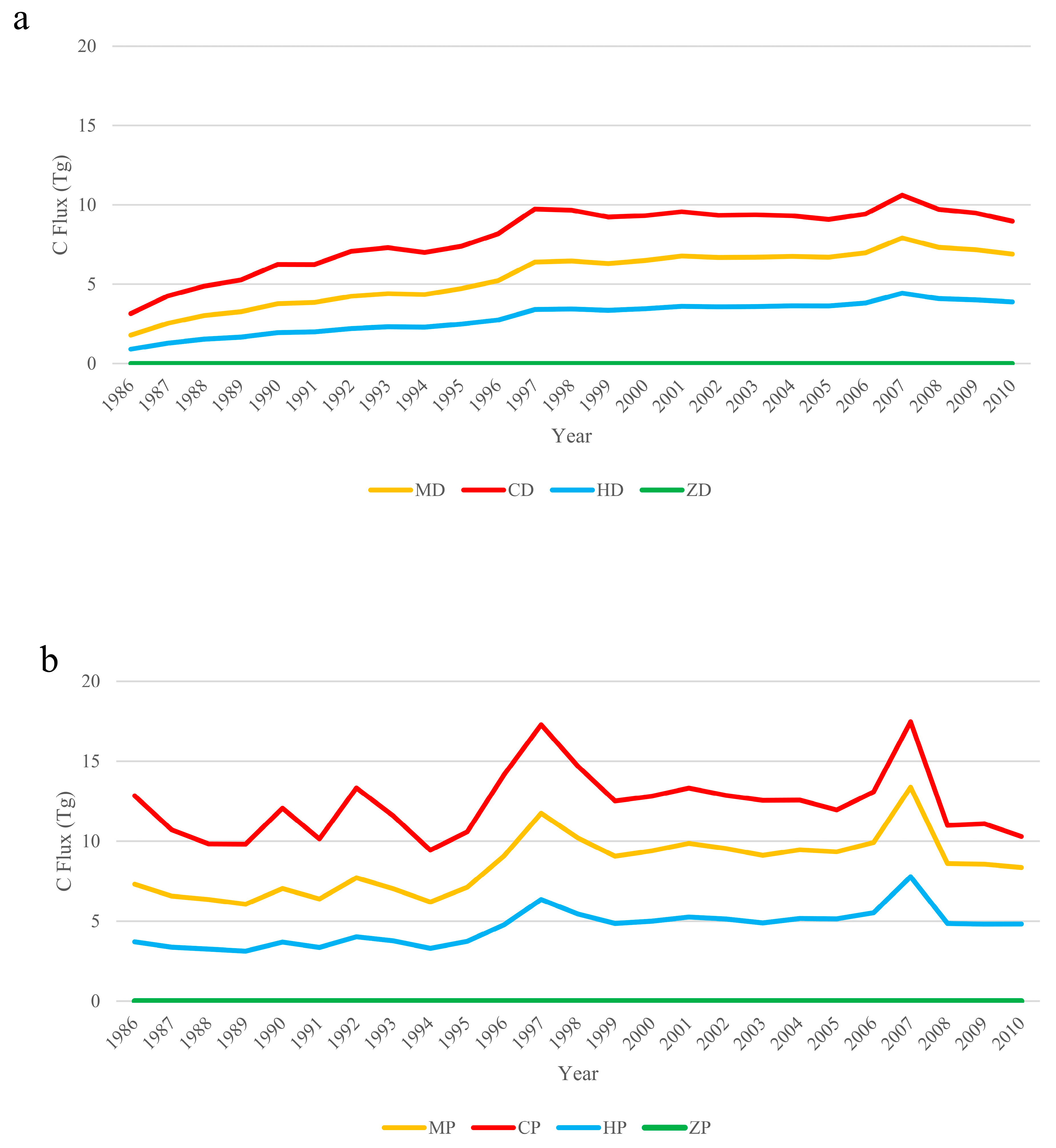An Improved Grid-Based Carbon Accounting Model for Forest Disturbances from Remote Sensing and TPO Survey Data
Abstract
1. Introduction
2. Methods
2.1. Study Area
2.2. The Original Grid-Based Carbon Accounting (GCA) Model and Model Inputs
2.3. GCA Model Improvement
2.3.1. Partitioning of Removed C by Disturbance Events
2.3.2. C Accumulation from Forest Growth
2.4. Model Corroboration
3. Results and Analysis
3.1. Improved Model’s Performance
3.2. North Carolina’s Forest Carbon Dynamics
4. Discussion
5. Conclusions
Author Contributions
Funding
Data Availability Statement
Acknowledgments
Conflicts of Interest
References
- Houghton, R.A. Terrestrial Fluxes of Carbon in GCP Carbon Budgets. Glob. Change Biol. 2020, 26, 3006–3014. [Google Scholar] [CrossRef]
- Le Quéré, C.; Andrew, R.M.; Friedlingstein, P.; Sitch, S.; Hauck, J.; Pongratz, J.; Pickers, P.A.; Korsbakken, J.I.; Peters, G.P.; Canadell, J.G.; et al. Global Carbon Budget 2018. Earth Syst. Sci. Data 2018, 10, 2141–2194. [Google Scholar] [CrossRef]
- Mitchard, E.T.A. The Tropical Forest Carbon Cycle and Climate Change. Nature 2018, 559, 527–534. [Google Scholar] [CrossRef]
- Fan, L.; Wigneron, J.-P.; Ciais, P.; Chave, J.; Brandt, M.; Sitch, S.; Yue, C.; Bastos, A.; Li, X.; Qin, Y.; et al. Siberian Carbon Sink Reduced by Forest Disturbances. Nat. Geosci. 2023, 16, 56–62. [Google Scholar] [CrossRef]
- Pugh, T.A.M.; Lindeskog, M.; Smith, B.; Poulter, B.; Arneth, A.; Haverd, V.; Calle, L. Role of Forest Regrowth in Global Carbon Sink Dynamics. Proc. Natl. Acad. Sci. USA 2019, 116, 4382–4387. [Google Scholar] [CrossRef] [PubMed]
- Ma, Z.; Peng, C.; Zhu, Q.; Chen, H.; Yu, G.; Li, W.; Zhou, X.; Wang, W.; Zhang, W. Regional Drought-Induced Reduction in the Biomass Carbon Sink of Canada’s Boreal Forests. Proc. Natl. Acad. Sci. USA. 2012, 109, 2423–2427. [Google Scholar] [CrossRef] [PubMed]
- Kurz, W.A.; Dymond, C.C.; Stinson, G.; Rampley, G.J.; Neilson, E.T.; Carroll, A.L.; Ebata, T.; Safranyik, L. Mountain Pine Beetle and Forest Carbon Feedback to Climate Change. Nature 2008, 452, 987–990. [Google Scholar] [CrossRef] [PubMed]
- White, J.C.; Wulder, M.A.; Hermosilla, T.; Coops, N.C.; Hobart, G.W. A Nationwide Annual Characterization of 25 Years of Forest Disturbance and Recovery for Canada Using Landsat Time Series. Remote Sens. Environ. 2017, 194, 303–321. [Google Scholar] [CrossRef]
- Kasischke, E.S.; Turetsky, M.R. Recent Changes in the Fire Regime Across the North American Boreal Region—Spatial and Temporal Patterns of Burning Across Canada and Alaska. Geophys. Res. Lett. 2006, 33, 3006–3014. [Google Scholar] [CrossRef]
- Loveland, T.R.; Dwyer, J.L. Landsat: Building a Strong Future. Remote Sens. Environ. 2012, 122, 22–29. [Google Scholar] [CrossRef]
- Wulder, M.A.; Loveland, T.R.; Roy, D.P.; Crawford, C.J.; Masek, J.G.; Woodcock, C.E.; Allen, R.G.; Anderson, M.C.; Belward, A.S.; Cohen, W.B.; et al. Current Status of Landsat Program, Science, and Applications. Remote Sens. Environ. 2019, 225, 127–147. [Google Scholar] [CrossRef]
- Kennedy, R.E.; Yang, Z.; Cohen, W.B. Detecting Trends in Forest Disturbance and Recovery Using Yearly Landsat Time Series: 1. LandTrendr—Temporal Segmentation Algorithms. Remote Sens. Environ. 2010, 114, 2897–2910. [Google Scholar] [CrossRef]
- Kennedy, R.E.; Cohen, W.B.; Schroeder, T.A. Trajectory-Based Change Detection for Automated Characterization of Forest Disturbance Dynamics. Remote Sens. Environ. 2007, 110, 370–386. [Google Scholar] [CrossRef]
- Huang, C.; Goward, S.N.; Masek, J.G.; Thomas, N.; Zhu, Z.; Vogelmann, J.E. An Automated Approach for Reconstructing Recent Forest Disturbance History Using Dense Landsat Time Series Stacks. Remote Sens. Environ. 2010, 114, 183–198. [Google Scholar] [CrossRef]
- Sulla-Menashe, D.; Kennedy, R.E.; Yang, Z.; Braaten, J.; Krankina, O.N.; Friedl, M.A. Detecting Forest Disturbance in the Pacific Northwest from MODIS Time Series Using Temporal Segmentation. Remote Sens. Environ. 2014, 151, 114–123. [Google Scholar] [CrossRef]
- Francini, S.; D’Amico, G.; Vangi, E.; Borghi, C.; Chirici, G. Integrating GEDI and Landsat: Spaceborne Lidar and Four Decades of Optical Imagery for the Analysis of Forest Disturbances and Biomass Changes in Italy. Sensors 2022, 22, 2015. [Google Scholar] [CrossRef]
- Diao, J.; Feng, T.; Li, M.; Zhu, Z.; Liu, J.; Biging, G.; Zheng, G.; Shen, W.; Wang, H.; Wang, J.; et al. Use of Vegetation Change Tracker, Spatial Analysis, and Random Forest Regression to Assess the Evolution of Plantation Stand Age in Southeast China. Ann. For. Sci. 2020, 77, 27. [Google Scholar] [CrossRef]
- Ye, J.; Wang, N.; Sun, M.; Liu, Q.; Ding, N.; Li, M. A New Method for the Rapid Determination of Fire Disturbance Events Using GEE and the VCT Algorithm—A Case Study in Southwestern and Northeastern China. Remote Sens. 2023, 15, 413. [Google Scholar] [CrossRef]
- Ding, N.; Li, M. Mapping Forest Abrupt Disturbance Events in Southeastern China—Comparisons and Tradeoffs of Landsat Time Series Analysis Algorithms. Remote Sens. 2023, 15, 5408. [Google Scholar] [CrossRef]
- Thomas, N.E.; Huang, C.; Goward, S.N.; Powell, S.; Rishmawi, K.; Schleeweis, K.; Hinds, A. Validation of North American Forest Disturbance Dynamics Derived from Landsat Time Series Stacks. Remote Sens. Environ. 2011, 115, 19–32. [Google Scholar] [CrossRef]
- Jiang, F.; Sun, H.; Chen, E.; Wang, T.; Cao, Y.; Liu, Q. Above-Ground Biomass Estimation for Coniferous Forests in Northern China Using Regression Kriging and Landsat 9 Images. Remote Sens. 2022, 14, 5734. [Google Scholar] [CrossRef]
- Neto, M.M.; da Silva, J.B.; de Brito, H.C. Carbon Stock Estimation in a Brazilian Mangrove Using Optical Satellite Data. Environ. Monit. Assess. 2023, 196, 9. [Google Scholar] [CrossRef]
- Zhang, Y.; Woodcock, C.E.; Chen, S.; Wang, J.A.; Sulla-Menashe, D.; Zuo, Z.; Olofsson, P.; Wang, Y.; Friedl, M.A. Mapping Causal Agents of Disturbance in Boreal and Arctic Ecosystems of North America Using Time Series of Landsat Data. Remote Sens. Environ. 2022, 272, 112935. [Google Scholar] [CrossRef]
- Tao, X.; Huang, C.; Zhao, F.; Schleeweis, K.; Masek, J.; Liang, S. Mapping Forest Disturbance Intensity in North and South Carolina Using Annual Landsat Observations and Field Inventory Data. Remote Sens. Environ. 2019, 221, 351–362. [Google Scholar] [CrossRef]
- Zhang, Y.; Shen, W.; Li, M.; Lv, Y. Assessing Spatio-Temporal Changes in Forest Cover and Fragmentation under Urban Expansion in Nanjing, Eastern China, from Long-Term Landsat Observations (1987–2017). Appl. Geogr. 2020, 117, 102190. [Google Scholar] [CrossRef]
- Markowski-Lindsay, M.; Brandeis, C.; Butler, B.J. USDA Forest Service Timber Products Output Survey Item Nonresponse Analysis. For. Sci. 2023, 69, 321–333. [Google Scholar] [CrossRef]
- Huang, C.; Ling, P.-Y.; Zhu, Z. North Carolina’s Forest Disturbance and Timber Production Assessed Using Time Series Landsat Observations. Int. J. Digit. Earth 2015, 8, 947–969. [Google Scholar] [CrossRef]
- Ling, P.-Y.; Baiocchi, G.; Huang, C. Estimating Annual Influx of Carbon to Harvested Wood Products Linked to Forest Management Activities Using Remote Sensing. Clim. Change 2016, 134, 45–58. [Google Scholar] [CrossRef]
- Gong, W.; Huang, C.; Zhao, F.; Lu, J. Estimation of Annual Harvested Wood Products Based on Remote Sensing and TPO Survey Data. Geo-Spat. Inf. Sci. 2024, 1–13. [Google Scholar] [CrossRef]
- Law, B.E.; Waring, R.H. Carbon Implications of Current and Future Effects of Drought, Fire and Management on Pacific Northwest Forests. For. Ecol. Manag. 2015, 355, 4–14. [Google Scholar] [CrossRef]
- Moomaw, W.R.; Law, B.E. A Call to Reduce the Carbon Costs of Forest Harvest. Nature 2023, 620, 44–45. [Google Scholar] [CrossRef] [PubMed]
- Peng, L.; Searchinger, T.D.; Zionts, J.; Waite, R. The Carbon Costs of Global Wood Harvests. Nature 2023, 620, 110–115. [Google Scholar] [CrossRef] [PubMed]
- Qing, T.; Wang, F.; Du, R.; Dong, G.; Tian, L. The Influence Patterns of Carbon Flux in Different Climatic Zones in China —Based on the Complex Network Approach. Europhys. Lett. 2024, 146, 31002. [Google Scholar] [CrossRef]
- Gong, W.; Huang, C.; Houghton, R.A.; Nassikas, A.; Zhao, F.; Tao, X.; Lu, J.; Schleeweis, K. Carbon Fluxes from Contemporary Forest Disturbances in North Carolina Evaluated Using a Grid-Based Carbon Accounting Model and Fine Resolution Remote Sensing Products. Sci. Remote Sens. 2022, 5, 100042. [Google Scholar] [CrossRef]
- Birdsey, R.; Pregitzer, K.; Lucier, A. Forest Carbon Management in the United States. J. Environ. Qual. 2006, 35, 1461–1469. [Google Scholar] [CrossRef]
- Corbera, E.; Schroeder, H. Governing and Implementing REDD+. Environ. Sci. Policy 2011, 14, 89–99. [Google Scholar] [CrossRef]
- Kurz, W.; Shaw, C.; Boisvenue, C.; Stinson, G.; Metsaranta, J.; Leckie, D.; Dyk, A.; Smyth, C.; Neilson, E. Carbon in Canada’s Boreal Forest—A Synthesis1. Environ. Rev. 2013, 21, 4. [Google Scholar] [CrossRef]
- Turetsky, M.R.; Abbott, B.W.; Jones, M.C.; Anthony, K.W.; Olefeldt, D.; Schuur, E.A.G.; Grosse, G.; Kuhry, P.; Hugelius, G.; Koven, C.; et al. Carbon Release Through Abrupt Permafrost Thaw. Nat. Geosci. 2020, 13, 138–143. [Google Scholar] [CrossRef]
- Lu, X.; Gilliam, F.S.; Yue, X.; Wang, B.; Kuang, Y. Shifts in Above-Versus Below-Ground Carbon Gains to Terrestrial Ecosystems Carbon Sinks Under Excess Nitrogen Inputs. Glob. Biogeochem. Cycles 2023, 37, e2022GB007638. [Google Scholar] [CrossRef]
- Hill, A.P.; Field, C.B. Forest Fires and Climate-Induced Tree Range Shifts in the Western US. Nat. Commun. 2021, 12, 6583. [Google Scholar] [CrossRef]
- Brown, M.; Eastell, L.; Gl, D.; Park, H.; Road, A. Alternatives to Venting of Natural Gas—ANG Gas Capture to Reduce Emissions. Available online: http://members.igu.org/old/IGU%20Events/igrc/igrc-2014/papers/fo4-2_brown.pdf (accessed on 28 February 2024).
- Houghton, R.A.; Hackler, J.L.; Lawrence, K.T. The U.S. Carbon Budget: Contributions from Land-Use Change. Science 1999, 285, 574–578. [Google Scholar] [CrossRef] [PubMed]
- Wilson, B.T.; Woodall, C.W.; Griffith, D.M. Imputing Forest Carbon Stock Estimates from Inventory Plots to a Nationally Continuous Coverage. Carbon Balance Manag. 2013, 8, 1. [Google Scholar] [CrossRef] [PubMed]
- Houghton, R.A.; Nassikas, A.A. Global and Regional Fluxes of Carbon from Land Use and Land Cover Change 1850–2015. Glob. Biogeochem. Cycles 2017, 31, 456–472. [Google Scholar] [CrossRef]
- Woodall, C.W.; Coulston, J.W.; Domke, G.M.; Walters, B.F.; Wear, D.N.; Smith, J.E.; Andersen, H.-E.; Clough, B.J.; Cohen, W.B.; Griffith, D.M.; et al. The U.S. Forest Carbon Accounting Framework: Stocks and Stock Change, 1990-2016; U.S. Department of Agriculture: Washington, DC, USA; Forest Service: Washington, DC, USA; Northern Research Station: Newtown Square, PA, USA, 2015; p. NRS-GTR-154. [Google Scholar]
- Han, F.X.; Plodinec, M.J.; Su, Y.; Monts, D.L.; Li, Z. Terrestrial Carbon Pools in Southeast and South-Central United States. Clim. Chang. 2007, 84, 191–202. [Google Scholar] [CrossRef]
- Zheng, D.; Heath, L.S.; Ducey, M.J.; Smith, J.E. Carbon Changes in Conterminous US Forests Associated with Growth and Major Disturbances: 1992–2001. Environ. Res. Lett. 2011, 6, 014012. [Google Scholar] [CrossRef]
- Domke, G.M.; Walters, B.F.; Nowak, D.J.; Smith, J.; Ogle, S.M.; Coulston, J.W.; Wirth, T.C. Greenhouse Gas Emissions and Removals from Forest Land, Woodlands, and Urban Trees in the United States, 1990–2018; Resource Update: Lake Town, Japan; U.S. Department of Agriculture: Washington, DC, USA; Forest Service: Washington, DC, USA; Northern Research Station: Newtown Square, PA, USA, 2020; Volume 227, pp. 1–5. [Google Scholar] [CrossRef]
- Canadell, J.G.; Raupach, M.R. Managing Forests for Climate Change Mitigation. Science 2008, 320, 1456–1457. [Google Scholar] [CrossRef]
- Naudts, K.; Chen, Y.; McGrath, M.J.; Ryder, J.; Valade, A.; Otto, J.; Luyssaert, S. Europe’s Forest Management Did Not Mitigate Climate Warming. Science 2016, 351, 597–600. [Google Scholar] [CrossRef]
- Nunery, J.S.; Keeton, W.S. Forest Carbon Storage in the Northeastern United States: Net Effects of Harvesting Frequency, Post-Harvest Retention, and Wood Products. For. Ecol. Manag. 2010, 259, 1363–1375. [Google Scholar] [CrossRef]
- Van Deusen, P. Carbon Sequestration Potential of Forest Land: Management for Products and Bioenergy Versus Preservation. Biomass Bioenergy 2010, 34, 1687–1694. [Google Scholar] [CrossRef]
- Ramankutty, N.; Gibbs, H.K.; Achard, F.; Defries, R.; Foley, J.A.; Houghton, R.A. Challenges to Estimating Carbon Emissions from Tropical Deforestation. Glob. Change Biol. 2007, 13, 51–66. [Google Scholar] [CrossRef]
- Fearnside, P.M. Greenhouse Gases from Deforestation in Brazilian Amazonia: Net Committed Emissions. Clim. Chang. 1997, 35, 321–360. [Google Scholar] [CrossRef]
- Zhou, Y.; Williams, C.A.; Hasler, N.; Gu, H.; Kennedy, R. Beyond Biomass to Carbon Fluxes: Application and Evaluation of a Comprehensive Forest Carbon Monitoring System. Environ. Res. Lett. 2021, 16, 055026. [Google Scholar] [CrossRef]
- Harris, N.L.; Gibbs, D.A.; Baccini, A.; Birdsey, R.A.; de Bruin, S.; Farina, M.; Fatoyinbo, L.; Hansen, M.C.; Herold, M.; Houghton, R.A.; et al. Global Maps of Twenty-First Century Forest Carbon Fluxes. Nat. Clim. Chang. 2021, 11, 234–240. [Google Scholar] [CrossRef]







| Name | Unit | Description |
|---|---|---|
| CPrim | g/Ha | Carbon density in undisturbed, mature/primary forest |
| CMin | g/Ha | Minimum carbon density after disturbance |
| CSec | g/Ha | Carbon density in recovered, secondary forest |
| FSlash | Fraction of carbon ended up in slash pool | |
| DRSlash | Year−1 | Decay rate coefficient for slash pool |
| FP1 | Fraction of carbon ended up in 1-year decay pool | |
| FP10 | Fraction of carbon ended up in 10-year decay pool | |
| FP100 | Fraction of carbon ended up in 100-year decay pool | |
| Tms | Year | Time for forest to grow into secondary forest from stand-clearing disturbance |
| Tsp | Year | Time for forest to grow into mature forest from secondary forest |
| Disturbance Intensity | Delayed Release | Prompt Release |
|---|---|---|
| Clear Cut (100%) | CD | CP |
| Mapped Intensity [24] | MD | MP |
| Half of Mapped Intensity | HD | HP |
| Zero Intensity | ZD | ZP |
Disclaimer/Publisher’s Note: The statements, opinions and data contained in all publications are solely those of the individual author(s) and contributor(s) and not of MDPI and/or the editor(s). MDPI and/or the editor(s) disclaim responsibility for any injury to people or property resulting from any ideas, methods, instructions or products referred to in the content. |
© 2024 by the authors. Licensee MDPI, Basel, Switzerland. This article is an open access article distributed under the terms and conditions of the Creative Commons Attribution (CC BY) license (https://creativecommons.org/licenses/by/4.0/).
Share and Cite
Gong, W.; Huang, C.; Xing, Y.; Lu, J.; Yang, H. An Improved Grid-Based Carbon Accounting Model for Forest Disturbances from Remote Sensing and TPO Survey Data. Forests 2024, 15, 2133. https://doi.org/10.3390/f15122133
Gong W, Huang C, Xing Y, Lu J, Yang H. An Improved Grid-Based Carbon Accounting Model for Forest Disturbances from Remote Sensing and TPO Survey Data. Forests. 2024; 15(12):2133. https://doi.org/10.3390/f15122133
Chicago/Turabian StyleGong, Weishu, Chengquan Huang, Yanqiu Xing, Jiaming Lu, and Hong Yang. 2024. "An Improved Grid-Based Carbon Accounting Model for Forest Disturbances from Remote Sensing and TPO Survey Data" Forests 15, no. 12: 2133. https://doi.org/10.3390/f15122133
APA StyleGong, W., Huang, C., Xing, Y., Lu, J., & Yang, H. (2024). An Improved Grid-Based Carbon Accounting Model for Forest Disturbances from Remote Sensing and TPO Survey Data. Forests, 15(12), 2133. https://doi.org/10.3390/f15122133








